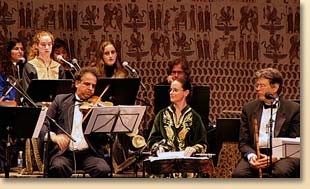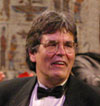|
The UCSB Middle
East Ensemble (MEE) is an official
“Ethnomusicology Performance
Ensemble” in the UCSB
Music Department.
Founded in 1989 by ethnomusicology
professor Scott
Marcus, the ensemble has
performed widely throughout
California and in Tucson, Arizona,
and Washington D.C. In Fall
1999, seven members of the
Ensemble performed in the
Central Asian country of
Uzbekistan as the sole U.S.
representatives at the
International “Melodies of
the East” Festival in the city of
Samarkand. In July 2010, the
Ensemble traveled to Egypt
to give a series of concerts
sponsored by the Egyptian
government’s Ministry of
Culture. With a group of 54
musicians, singers, and dancers,
the Ensemble presented nine
concerts over a two-week period,
the highlight being four
performances at the Cairo Opera
House, the premier performance
venue in Egypt, with additional
performances at Cairo University
and in the cities of Ismailia,
Helwan, and Beni Suef. We
also performed for the Nevada
Museum of Art in June 2011 on the
occasion of the museum’s 80th-year
celebration.
 The ensemble’s
repertoire reflects the great
diversity of cultures found in the
Middle East. The ensemble performs
music and dance from Arab,
Turkish, Persian, Armenian, Greek,
Sephardic and Oriental Jewish,
Kurdish, and Assyrian cultures.
Performance items range from
classical pieces to religious,
folk, popular, and children’s
songs, as well as folk, classical,
and cabaret-style dances. The ensemble’s
repertoire reflects the great
diversity of cultures found in the
Middle East. The ensemble performs
music and dance from Arab,
Turkish, Persian, Armenian, Greek,
Sephardic and Oriental Jewish,
Kurdish, and Assyrian cultures.
Performance items range from
classical pieces to religious,
folk, popular, and children’s
songs, as well as folk, classical,
and cabaret-style dances.
The MEE performs
on traditional instruments such as
the pan-Middle Eastern
short-necked lute (the `ud), the
Turkish long-necked lute (the
baglama saz) the end-blown reed
flute (the nay), the Persian
hammered dulcimer (the santur),
the Arab/Turkish plucked dulcimer
(qanun or kanun), the Egyptian
spiked fiddle (the rabab), the
Turkish and Egyptian oboes (the
zurna and mizmar), and a variety
of Middle Eastern drums (the
darbukkah, riqq, bendir, mazhar,
tabl baladi, and zarb). In
addition, the Ensemble uses the
accordion (retuned to accomodate
Middle Eastern scales), the
violin, cello, double bass, and on
occasion, the guitar and
saxophone.
The Friends
of Middle Eastern Music
Association (FOMEMA) is an
association formed to promote
interaction between the Santa
Barbara community and the UCSB
Middle East Ensemble, explore ways
in which the Ensemble can support
the larger community in the
presentation of Middle Eastern
culture, and ways in which the
community can support the
Ensemble’s goals of an expanded
role at UCSB for study and
research in Middle Eastern music
and culture.
 The Ensemble has
three commercial CD’s, entitled
“UCSB Middle East Ensemble In
Concert 1994”, ”UCSB Middle East
Ensemble, 1995”, and “UCSB Middle
East Ensemble, 1996”, as well as a
DVD and t-shirts. Two of the CD’s
have accompanying booklets with
lyrics and musical scores. These
products are available outside the
concert hall during the Ensemble's
performances and also at our Store
page. The Ensemble has
three commercial CD’s, entitled
“UCSB Middle East Ensemble In
Concert 1994”, ”UCSB Middle East
Ensemble, 1995”, and “UCSB Middle
East Ensemble, 1996”, as well as a
DVD and t-shirts. Two of the CD’s
have accompanying booklets with
lyrics and musical scores. These
products are available outside the
concert hall during the Ensemble's
performances and also at our Store
page.
The ensemble
performs at various sizes. At its
fullest, the instrumental section
of the ensemble is a 40 to
45-member orchestra; the chorus
has 10-12 members; and dancers
number up to a dozen. For our
"road performances," we often
present a smaller group of 20-30
members.
The ensemble's
performances are noted for being
colorful and fast-paced. Following
a tradition developed in Cairo,
Beirut, and Damascus, men wear
tuxedos while women wear colorful
traditional dresses. Group
instrumental pieces are quickly
juxtaposed with solo
instrumentals, solo vocals are
answered by choral pieces, with
solo and group dances interspersed
throughout. Performances generally
end with an extended cabaret-style
dance set.
 Scott
Marcus Scott
Marcus
Founder and director Dr. Scott
Marcus received his Ph.D. in
music/ethnomusicology from UCLA in
1989, with a doctoral dissertation
entitled Arab Music Theory in the
Modern Period. In addition to his
studies at UCLA under A. Jihad
Racy, Scott also studied in Cairo,
Egypt with a number of the main
teachers at Cairo's two music
institutes (al-Ma`had al-`Ali
li-l-Musiqa al-`Arabiyyah, i.e.,
The Higher Institute for Arab
Music, and Kulliyat al-Tarbiyyah
al-Musiqiyyah, i.e., The Faculty
of Music Education, Helwan
University). A UCSB Pofessor since
1989, Scott teaches in the Music
Department's Program in
Ethnomusicology. Students can earn
the B.A., M.A., and Ph.D. in
Ethnomusicology with an emphasis
in Middle Eastern Music.
 Cris!
Basimah Cris!
Basimah
The Dance Director for the
University of California, Santa
Barbara (UCSB) Middle East
Ensemble.
Cris! Basimah is an award-winning
belly dancer from Santa Barbara,
California, specializing in dance
styles of the Middle East
(including Raqs sharqi) and Latin
cultures. Trained in classic and
modern ballet, Latin dance styles,
Egyptian, Turkish, American
Cabaret and Folkloric dance from
numerous oriental regions, Cris!
mixes a wide variety of techniques
for dance to produce entertaining,
educating and often innovative
performances. She teaches beginner
and intermediate belly dance
classes at the Gustafson Dance
Studio and performs regularly at
Santa Barbara's Middle Eastern
restaurant Zaytoon.
 Susan
Rudnicki Susan
Rudnicki
Sue has lead the percussion
section since she co-founded the
Ensemble in 1989. She has studied
Arabic drumming with Souhail
Kaspar, Persian drumming with
Mehrdad Arabifard and Siamak
Pouian, the Armenian d'hol
with Sarkis Petrossian, and the
Uzbek doire with Tolkin
Isakov. She is a lecturer in the
Music Department and, in addition
to being the Ensemble percussioin
director, she teaches percussion
in music.
The
Unique UCSB Middle East Ensemble
(The MEE featured in
the press)
The University
of California at Santa Barbara can
now boast of being home to North
America's largest Middle Eastern
orchestra. The UCSB Middle East
Music Ensemble's emergence as a
major cultural presence in Santa
Barbara and Los Angeles areas is
drawing acclaim and support from
nearly a dozen different Middle
Eastern communities, as well as a
loyal following from the
university and other local
audiences.
Since 1989 the
MEE has been a learning aid for
the ethnomusicology students.
However, the vitality and sheer
distinctiveness of the group's
performances have propelled it
into becoming a vibrant orchestra
of 55 members
including a dance troupe and
chorus. The ensemble has been
attracting sell-out crowds
throughout California.
Since its
inception the ensemble has
continually drawn in new members
from the university's students,
faculty, and the larger community.
Though a small number of
participants are from the Middle
East, one of the unique
characteristics of the group is
that it is composed of Americans
of non-Middle Eastern origin who
have been attracted by the
opportunity to gain hands-on
experience of other cultures.
Professor Scott
Marcus, the ensemble's founder and
director, remarks, "One of the
first realizations of any new
member in our group is the
astonishing number and diversity
of cultures and musics found in
the Middle East." Within the first
few weeks of rehearsal students
might encounter the driving
rhythms of a Lebanese dabke folk
dance, the full orchestral sound
of modern Egyptian popular song,
the syncopated accents of Turkish
folk music, and the intricate
melodies of Persian music.
The ensemble
also performs music and dance of
Armenia, Morocco, Algeria, Syria,
Saudi Arabia, the
Assyrian-Chaldean Christians of
Iraq, Israel, and includes
repertory from the Sufi mystical
tradition of Islam. Marcus added:
"One student recently told me, 'I
didn't even know half these groups
existed and here I am playing
their music.' That is exactly the
type of reaction we strive for
from both our participants and our
audiences, a recognition of the
vast array of ethnicities and
cultures present in the Middle
East that are so often ignored in
media portrayals of the region."
The ensemble
plays a special role for the many
Middle Eastern communities of
Southern California. Its
performances provide public
recognition and a significant
affirmation of the cultural roots
of these communities. It has also
become a resource for educating
second-generation young people
about their musical heritage. "The
father of one student of Arab
origin recently remarked to me, 'I
always wanted my son to learn
something about Arab music, but it
wasn't till he discovered your
group that he got motivated to do
so," said Marcus. The ensemble's
performances are visually
stunning. For formal concerts, in
accordance with standards set in
Cairo, Damascus, and Beirut, the
men wear tuxedos and the women don
vibrant traditional dresses. The
dance troupe perform in colorful
costumes from around the Middle
East. The stage is crowded with
performers playing instruments of
all shapes and sizes. Some are
familiar to western audiences such
as violins, accordion (tuned for
Middle Eastern scales), and
doublebass. But most are unique to
the Middle East such as Arab and
Turkish lutes (ud and saz), reed
flute (nay), plucked and hammered
zithers (qanun and santur), and a
wide variety of percussion
instruments (dumbek, darabukkah,
zarb, tar, and daff).
During
performances, Marcus gives the
audience a brief introduction to
the music: where it comes from,
what it is about, and also
introduces the different
instruments, rhythms, and melodic
modes. Audience members receive
printed programs which include
song lyrics and translations.
The remarkable
popularity of the ensemble lies in
part in the ever-changing texture
of its performances. Orchestral
pieces are interwoven with
instrumental solos' group dances,
choral numbers, solo vocalists,
and solo dancers. The result is a
fast-paced, highly-entertaining
evening for one and all. "We have
an extremely enthusiastic mix of
students, teachers, and community
members who have come together to
give the group real momentum. Our
rehearsals and shows are like
family gatherings, and I think
that it infectious," says Marcus.
The group
performs regularly throughout
California, often playing
full-houses at concerts sponsored
by ethnic groups like the Syrian
Arab American Association. These
groups have responded with
tremendous support for the
ensemble, contributing their time
and resources to promote the
ensemble and its ongoing efforts.
Santa Barbara
audiences for their part have
formed a community-based
organization, the Friends of
Middle Eastern Music Association,
to raise money for the Ensemble's
ongoing needs, create scholarships
for university students studying
Middle Eastern music, and in
general to encourage and support
the ensemble's continuing efforts
to promote cultural awareness of
the Middle East.
|

 The ensemble’s
repertoire reflects the great
diversity of cultures found in the
Middle East. The ensemble performs
music and dance from Arab,
Turkish, Persian, Armenian, Greek,
Sephardic and Oriental Jewish,
Kurdish, and Assyrian cultures.
Performance items range from
classical pieces to religious,
folk, popular, and children’s
songs, as well as folk, classical,
and cabaret-style dances.
The ensemble’s
repertoire reflects the great
diversity of cultures found in the
Middle East. The ensemble performs
music and dance from Arab,
Turkish, Persian, Armenian, Greek,
Sephardic and Oriental Jewish,
Kurdish, and Assyrian cultures.
Performance items range from
classical pieces to religious,
folk, popular, and children’s
songs, as well as folk, classical,
and cabaret-style dances. The Ensemble has
three commercial CD’s, entitled
“UCSB Middle East Ensemble In
Concert 1994”, ”UCSB Middle East
Ensemble, 1995”, and “UCSB Middle
East Ensemble, 1996”, as well as a
DVD and t-shirts. Two of the CD’s
have accompanying booklets with
lyrics and musical scores. These
products are available outside the
concert hall during the Ensemble's
performances and also at our
The Ensemble has
three commercial CD’s, entitled
“UCSB Middle East Ensemble In
Concert 1994”, ”UCSB Middle East
Ensemble, 1995”, and “UCSB Middle
East Ensemble, 1996”, as well as a
DVD and t-shirts. Two of the CD’s
have accompanying booklets with
lyrics and musical scores. These
products are available outside the
concert hall during the Ensemble's
performances and also at our  Scott
Marcus
Scott
Marcus Cris!
Basimah
Cris!
Basimah Susan
Rudnicki
Susan
Rudnicki